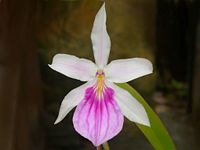Miltonia: Difference between revisions
imported>Dalton Holland Baptista No edit summary |
imported>Dalton Holland Baptista No edit summary |
||
| Line 25: | Line 25: | ||
| subdivision2 = | | subdivision2 = | ||
*''Anneliesia'' <small> [[Brieger]] & [[Lückel]] 1983</small> | *''Anneliesia'' <small> [[Brieger]] & [[Lückel]] 1983</small> | ||
*''Gynizodon'' <small> [[Raf.]] 1838</small> | |||
*''Macrochilus''<small> [[Knowles]] & [[Westc.]] 1837</small> | *''Macrochilus''<small> [[Knowles]] & [[Westc.]] 1837</small> | ||
}} | }} | ||
'''''Miltonia''''' is an [[orchid]] genus formed by nine | '''''Miltonia''''' is an [[orchid]] genus formed by nine [[epiphyte]] species and seven natural hybrids inhabitants of [[Brazil]]ian [[Atlantic Forest]], one species reaching the northeast of [[Argentina]] and east of [[Paraguay]]. This genus was established by [[John Lindley]] in 1837, when he described its [[type species]], ''[[Miltonia spectabilis]]''. Many species were attributed to ''Miltonia'' in the past, however, today, the species from [[Central America]] and from cooler areas on northwest of [[South America]] have been moved to other genera. ''Miltonia'' usually have large and long lasting flowers, often in inflorescences with several of them. This fact, allied to being species that are easy to grow, make them a favorite of orchid collectors all over the world. | ||
''Miltonia'' | ==Distribution== | ||
''Miltonia'' species range starts on the area of [[Missiones]] in the northeast of Argentina and east of Paraguay and spreads north along the Brazilian mountains of [[Serra do Mar]] and its branches up to the State of [[Pernambuco]] on Brazilian northeast. They occupy mostly areas between 200 and 1,500 meters of altitude meters, however the majority of the species are more often found about 600 to 900 meters. ''Miltonia'' species can be found from shady areas inside the forest to areas more exposed to the sun, however never are under full sunlight; usually in ventilated places where they receive plenty humidity during the night and early morning. They are always epiphyte and, because they grow very fast, each pseudobulb originating two new growths every year, they soon form large colonies. | |||
''Miltonia russelliana'' and ''M. flavescens'' are the ones with the widest dispersion and found at lower altitudes. ''M. flavescens'' is the only species that exists in countries other than Brazil and is also the one that spreads farther north. ''M russelliana'' range starts on [[Rio Grande do Sul]] and ends at [[Bahia]] State. ''M. regnellii'' is also widespread although does not go northern than [[Rio de Janeiro State|Rio de Janeiro]]. ''M. moreliana'' is a species more common at lower altitudes and warmer areas existing from Rio to Pernambuco. ''Miltonia candida'', ''M. clowesii'' and ''M. spectabilis'' are restricted to the four states of [[Region Southeast of Brazil]]. ''Miltonia cuneata'' is just from [[São Paulo State|São Paulo]] and Rio and the one that grow at highest altitudes. ''M. kayasimae'' is the only species really rare; it has been found just a couple of times in a very restricted area close to [[Salesópolis]], in São Paulo State. | |||
==Description== | |||
Revision as of 20:10, 16 March 2009
| Miltonia | ||||||||||||||||||||
|---|---|---|---|---|---|---|---|---|---|---|---|---|---|---|---|---|---|---|---|---|
 Miltonia spectabilis
| ||||||||||||||||||||
| Scientific classification | ||||||||||||||||||||
| ||||||||||||||||||||
| Type species | ||||||||||||||||||||
| Miltonia spectabilis Lindl. 1837 | ||||||||||||||||||||
| Species | ||||||||||||||||||||
| ||||||||||||||||||||
| Synonyms | ||||||||||||||||||||
Miltonia is an orchid genus formed by nine epiphyte species and seven natural hybrids inhabitants of Brazilian Atlantic Forest, one species reaching the northeast of Argentina and east of Paraguay. This genus was established by John Lindley in 1837, when he described its type species, Miltonia spectabilis. Many species were attributed to Miltonia in the past, however, today, the species from Central America and from cooler areas on northwest of South America have been moved to other genera. Miltonia usually have large and long lasting flowers, often in inflorescences with several of them. This fact, allied to being species that are easy to grow, make them a favorite of orchid collectors all over the world.
Distribution
Miltonia species range starts on the area of Missiones in the northeast of Argentina and east of Paraguay and spreads north along the Brazilian mountains of Serra do Mar and its branches up to the State of Pernambuco on Brazilian northeast. They occupy mostly areas between 200 and 1,500 meters of altitude meters, however the majority of the species are more often found about 600 to 900 meters. Miltonia species can be found from shady areas inside the forest to areas more exposed to the sun, however never are under full sunlight; usually in ventilated places where they receive plenty humidity during the night and early morning. They are always epiphyte and, because they grow very fast, each pseudobulb originating two new growths every year, they soon form large colonies.
Miltonia russelliana and M. flavescens are the ones with the widest dispersion and found at lower altitudes. M. flavescens is the only species that exists in countries other than Brazil and is also the one that spreads farther north. M russelliana range starts on Rio Grande do Sul and ends at Bahia State. M. regnellii is also widespread although does not go northern than Rio de Janeiro. M. moreliana is a species more common at lower altitudes and warmer areas existing from Rio to Pernambuco. Miltonia candida, M. clowesii and M. spectabilis are restricted to the four states of Region Southeast of Brazil. Miltonia cuneata is just from São Paulo and Rio and the one that grow at highest altitudes. M. kayasimae is the only species really rare; it has been found just a couple of times in a very restricted area close to Salesópolis, in São Paulo State.